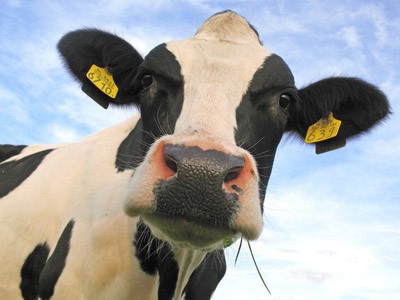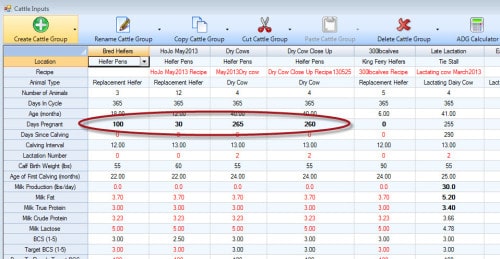
AMTS.Pro is a complex and detailed program based on CNCPS 6.1 biology. When fully utilized it very accurately predicts animal performance, both in terms of productive output (milk, growth) and excretions. When you first begin modeling a new farm there is A LOT of information to collect and key in. It can be pretty daunting. However; some inputs are more important to the model than others. Throughout the program we have indicated these inputs by bolding the numbers as they are keyed in.
As mentioned in the post from day 2, the temperature the animal is exposed to in the barn or location they reside influences DMI. The distance walked can have an effect on production in that for every kilometer walked, milk production will decrease by 500 ml, if the increased nutrient requirement for exercise is not accounted for in the recipe.

There are a number of bolded inputs on the Cattle window.
For Dry cows and bred heifers Pregnancy affects ME and MP requirements starting at 191 days. Lactating cows typically have reduced DMI until greater than 14 days post calving.
Milk Production drives ME and MP. Milk Protein composition is reliant on MP and aa balance. While not a bolded input, Body Condition Score (BCS) and be used to drive up ME requirement and allow formulation of diets for increasing milk production. The numbers in RED on the Cattle window derive their values from other inputs and cannot be directly changed.
THE MEAN FULL BODY WEIGHT AND MATURE FULL BODY WEIGHT ARE THE MOST IMPORTANT NUMBERS IN THE PROGRAM. Weight is used in almost every equation. It is used in equations that:
- Predict Intake
- Energy Maintenance
- Protein Maintenance
- Passage Rate
- Growth
- Pregnancy
- Reserves
As Tom has stated, “A key component to the successful implementation of the model is to accurately characterize the animal being fed. Data requirements include animal bodyweight, milk, milk components, days pregnant, distances walked, feed inventories, and dry matter intakes, to list the critical few. As a nutritionist, less data available (or poor quality data) results in over-formulation to avoid production variability. This results in higher costs and higher nutrient excretion. Bodyweight is by far the most critical data point and yet the most often missing. Bodyweight is used in nearly every sub-model and accounts for 50% of the intake prediction.”




